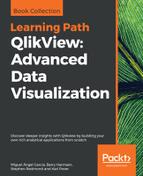As part of our balanced scorecard in Chapter 19, Balanced Scorecard, we purposed giving sales representatives a tool that allowed them to analyze cross-selling opportunities. We've decided to deliver this tool using Qlik Sense for the following two reasons:
- Nontechnical users, such as sales representatives, can create their own analysis
- Developers can create more powerful visualization extensions to help sales representatives discover cross-selling opportunities
The following three Qlik Sense data visualizations were created by Ralf Becher (http://irregular-bi.tumblr.com/). The first chart is a table that contains a numerical interpretation of how different items or item sets are related. It was created using a data mining algorithm called Apriori (https://en.wikipedia.org/wiki/Apriori_algorithm), which is used to discover associations between items or item sets and is a popular method to perform basket analysis.
Although we can use native QlikView and Qlik Sense to analyze individual associations, a visualization extension using the Apriori algorithm offers a more robust solution to discover the statistical correlation of every possible association. Similarly to how we use R-squared along with a scatterplot to understand correlations, we use confidence, support, and lift to understand association rules.
The first row in the table in the next figure evaluates the association rule, "If Toughfind 1292 and True Ronlam are purchased, then Stathold is purchased by the same customer." According to this table, Toughfind 1292, True Ronlam, and Stathold are purchased by 22.2% of all customers (Support). Also, if a customer purchases Toughfind 1292, True Ronlam, they are 100% likely to purchase Stathold (Confidence).
The final column, called Lift, takes Confidence and divides it by the overall probability that a customer purchases Stathold. For example, if Stathold was purchased by 50% of all customers, then Lift would be 2.00 (100%/50%). This would imply that there is a relationship between purchasing Stathold, given that a customer purchases Toughfind 1292, and True Ronlam. In short, a Lift greater than 1.00 implies an association between the item sets, and the greater the lift, the stronger the relationship. In the case of Toughfind 1292, True Ronlam, and Stathold, a lift of 4.5 indicates a strong association:

The table in the previous figure alone is powerful, but there are also a couple of visualizations that we can use to detect any customer purchase behavior that would otherwise be difficult to discover. We can also use them to give us a general overview of the data. Again, we use extensions to visualize this complex dataset that would otherwise be laborious, if not impossible, to create through native objects.
The first chart is a network chart that connects customer nodes to the product nodes that they purchase. Along with the Gestalt principle of connection to perceive the general connectivity between products and customers, we also use the principle of proximity to detect clusters that may indicate stronger relationships. For example, the remoteness of the customer Wordtune indicates how little their purchasing behavior has in common with that of other customers:

Another example is the cluster of product nodes that comprises the products, Hot Tom, Triolam, and Jobdax, that indicates a strong relationship between them. Upon further investigation, we confirm that all three products are purchased by the same customers. We can find cross-selling opportunities by zooming in on these product clusters to see which customers have yet to purchase one of the related products. We could also do the inverse and zoom in on related customer clusters and look for products which have not been purchased by every related customer.
We could also make cross-selling recommendations based on the length of the path between customer and product nodes. For example, Customer A's path to Product Y is three nodes long if Customer A purchases the same Product X as Customer B, who, in turn, also purchases Product Y. Therefore, we may have an opportunity to sell Product Y to Customer A:

In order to create a list of opportunities based on path distance, we calculate the shortest path between customer and product nodes using the Dijkstra algorithm (https://en.wikipedia.org/wiki/Dijkstra's_algorithm) and define the maximum path length that we will interpret as an opportunity. As a longer path implies a weaker relationship between a product and its potential buyer, we create our recommendations using paths of three or fewer nodes. Using the path shown in the previous figure as an example, we will see both Product Y (3-node path) and Product X (1-node path) being recommended for sale to Customer A.
Finally, we visualize these cross-selling recommendations using a Sankey chart that is similar to the one we use in the marketing perspective in Chapter 14, Marketing Perspective. In the chart, we can visualize the general extent of the cross-selling opportunities through the connections between customer and product. We can also perceive the number of opportunities per customer and per product through the size of the bar that represents them. For example, the outlier, Wordtune, has the most cross-selling recommendations. On the other hand, there are few opportunities to cross-sell the Zamex and Trisdox products:

The Qlik Sense visualization extensions that Ralf Becher created are an example of what we can expect from those who want to also become masters in Qlik Sense data visualization. For those of us who have mastered QlikView and are excited to meet this new challenge, let's go over the top-ten list of things that will be important to us during the next year as we learn to master Qlik Sense.
